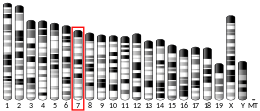KCNC3
Potassium voltage-gated channel, Shaw-related subfamily, member 3 also known as KCNC3 or Kv3.3 is a protein that in humans is encoded by the KCNC3.[5]
Function
The Shaker gene family of Drosophila encodes components of voltage-gated potassium channels and comprises four subfamilies. Based on sequence similarity, this gene is similar to one of these subfamilies, namely the Shaw subfamily. The protein encoded by this gene belongs to the delayed rectifier class of channel proteins and is an integral membrane protein that mediates the voltage-dependent potassium ion permeability of excitable membranes.[6][7][8]
Clinical significance
KCNC3 is associated with spinocerebellar ataxia type 13.[9]
See also
References
- GRCh38: Ensembl release 89: ENSG00000131398 - Ensembl, May 2017
- GRCm38: Ensembl release 89: ENSMUSG00000062785 - Ensembl, May 2017
- "Human PubMed Reference:". National Center for Biotechnology Information, U.S. National Library of Medicine.
- "Mouse PubMed Reference:". National Center for Biotechnology Information, U.S. National Library of Medicine.
- Ghanshani S, Pak M, McPherson JD, Strong M, Dethlefs B, Wasmuth JJ, Salkoff L, Gutman GA, Chandy KG (February 1992). "Genomic organization, nucleotide sequence, and cellular distribution of a Shaw-related potassium channel gene, Kv3.3, and mapping of Kv3.3 and Kv3.4 to human chromosomes 19 and 1". Genomics. 12 (2): 190–6. doi:10.1016/0888-7543(92)90365-Y. PMID 1740329.
- "Entrez Gene: potassium voltage-gated channel".
- Haas M, Ward DC, Lee J, Roses AD, Clarke V, D'Eustachio P, Lau D, Vega-Saenz de Miera E, Rudy B (December 1993). "Localization of Shaw-related K+ channel genes on mouse and human chromosomes". Mamm. Genome. 4 (12): 711–5. doi:10.1007/BF00357794. PMID 8111118.
- Gutman GA, Chandy KG, Grissmer S, Lazdunski M, McKinnon D, Pardo LA, Robertson GA, Rudy B, et al. (December 2005). "International Union of Pharmacology. LIII. Nomenclature and molecular relationships of voltage-gated potassium channels". Pharmacol. Rev. 57 (4): 473–508. doi:10.1124/pr.57.4.10. PMID 16382104.
- Waters MF, Pulst SM (2008). "Sca13". Cerebellum. 7 (2): 165–9. doi:10.1007/s12311-008-0039-7. PMID 18592334.
Further reading
- Wang D, Youngson C, Wong V, Yeger H, Dinauer MC, Vega-Saenz Miera E, Rudy B, Cutz E (1996). "NADPH-oxidase and a hydrogen peroxide-sensitive K+ channel may function as an oxygen sensor complex in airway chemoreceptors and small cell lung carcinoma cell lines". Proc. Natl. Acad. Sci. U.S.A. 93 (23): 13182–7. doi:10.1073/pnas.93.23.13182. PMC 24067. PMID 8917565.
- Rae JL, Shepard AR (2000). "Kv3.3 potassium channels in lens epithelium and corneal endothelium". Exp. Eye Res. 70 (3): 339–48. doi:10.1006/exer.1999.0796. PMID 10712820.
- Waters MF, Minassian NA, Stevanin G, Figueroa KP, Bannister JP, Nolte D, Mock AF, Evidente VG, Fee DB, Müller U, Dürr A, Brice A, Papazian DM, Pulst SM (2006). "Mutations in voltage-gated potassium channel KCNC3 cause degenerative and developmental central nervous system phenotypes". Nat. Genet. 38 (4): 447–51. doi:10.1038/ng1758. PMID 16501573.
- Brusco A, Gellera C, Cagnoli C, Saluto A, Castucci A, Michielotto C, Fetoni V, Mariotti C, Migone N, Di Donato S, Taroni F (2004). "Molecular genetics of hereditary spinocerebellar ataxia: mutation analysis of spinocerebellar ataxia genes and CAG/CTG repeat expansion detection in 225 Italian families". Arch. Neurol. 61 (5): 727–33. doi:10.1001/archneur.61.5.727. PMID 15148151.
- Herman-Bert A, Stevanin G, Netter JC, Rascol O, Brassat D, Calvas P, Camuzat A, Yuan Q, Schalling M, Dürr A, Brice A (2000). "Mapping of Spinocerebellar Ataxia 13 to Chromosome 19q13.3-q13.4 in a Family with Autosomal Dominant Cerebellar Ataxia and Mental Retardation". Am. J. Hum. Genet. 67 (1): 229–35. doi:10.1086/302958. PMC 1287081. PMID 10820125.
This article incorporates text from the United States National Library of Medicine, which is in the public domain.



